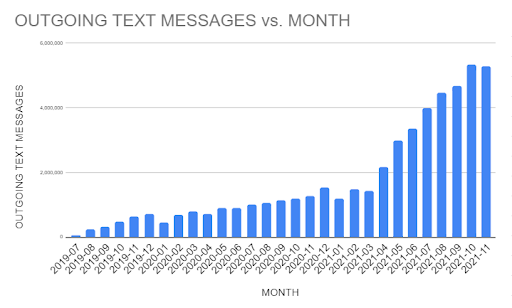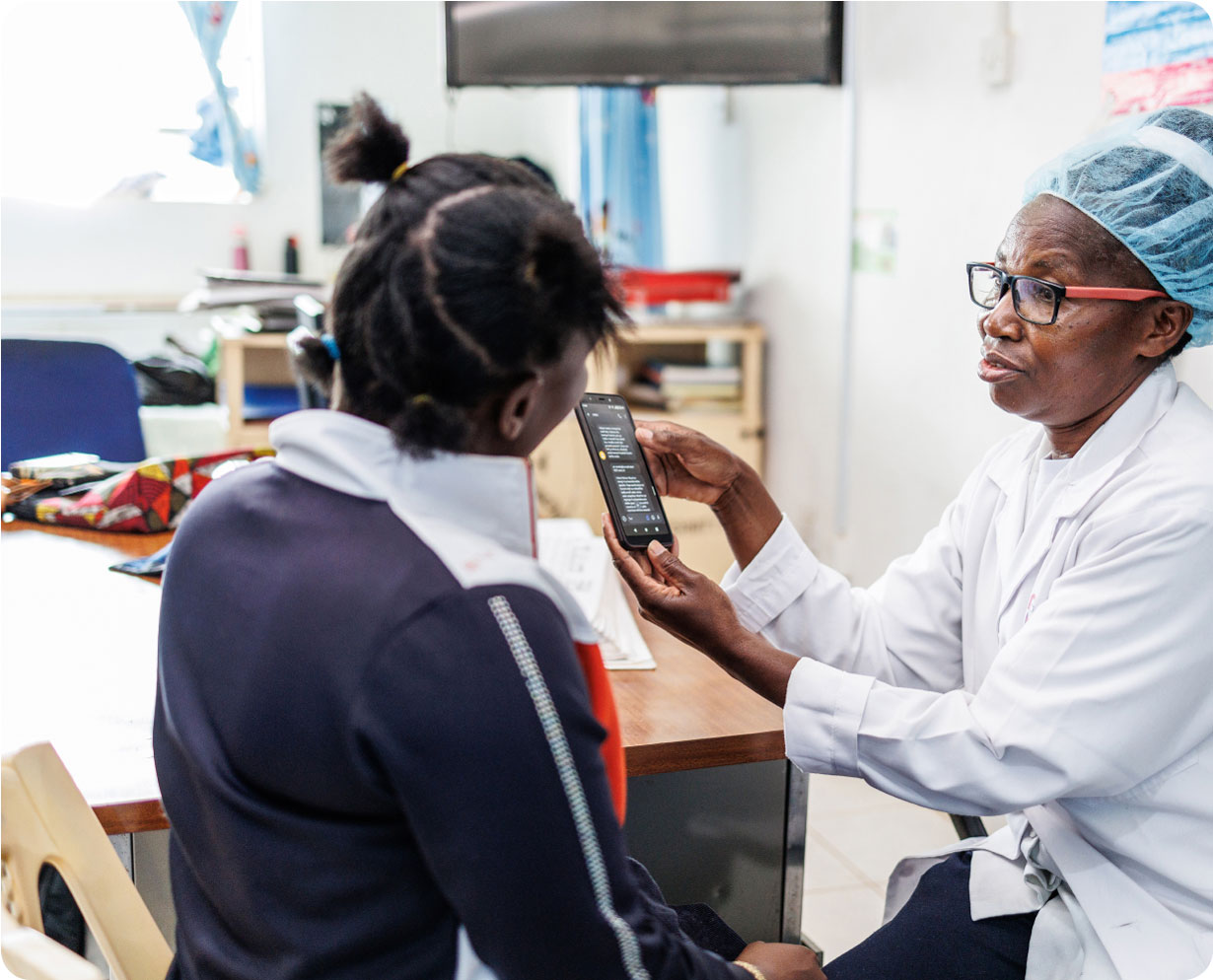If we’ve learnt one thing through COVID-19, it’s the power of accurate information and the threat of its absence. When it comes to maternal and newborn health, information is the lynchpin to mums seeking care at the right time and place, helping mums recognize – in time – signs that they or their baby may be at risk.
This November marks a major milestone at Jacaranda; sending our 50th millionth message to mums through PROMPTS. Our digital health tool combines carefully-designed ‘nudge’ messages, reminding mums of appointment reminders for antenatal and postnatal care or when to take their babies for immunization, alongside a two-way messaging service where mums send in their questions and receive tailored advice or referral if urgent.
In October alone, 5 million of these messages were sent to mums, the highest to date. The figure, of course, is an encouraging benchmark of our current capacity and demand, but as our platform grows both in Kenya and within new countries, our priority is always that quantity does not replace quality, and mums continue to receive timely, clinically-accurate messages tailored to their needs. The tangible impact we’ve seen so far in shifting health seeking behavior is testament to this approach; women on the platform are 20% more likely to seek prenatal care and uptake of family planning has doubled. We do this by staying true to three principles – equity, relevance, and speed – as we test and adapt our messages.

Making it equitable
When Jacaranda’s leadership first sat down and discussed the idea of a maternal health messaging service for mums, they wanted to make sure that all women – regardless of socio-economic background, location, age, or stage of pregnancy – could access lifesaving information and knowledge – as an integral part of our equity mission. Recognizing that financial barriers prevent many women in Kenya from seeking timely care, SMS became the clear front runner for the technology it would run on, accessible to over 95% of the population, widely cheaper than buying data, and using no storage memory (unlike an app).
The sudden prevalence of maternal health apps, of course, is encouraging – but it’s also limiting, given they pass the cost onto the client. Smartphone penetration is sharply rising across sub Saharan Africa, but a significant proportion of the population still use feature phones. Widespread digital connectivity is an exciting prospect and may be ubiquitous some day, but before this happens, our efforts will continue to be channeled first towards reaching the ‘last mile’ of mums and babies through technology that caters for everyone.
Making it relevant
Sending out millions of messages is all well and good, but if it doesn’t resonate or make sense to its receiver, it’s futile. It comes back to the age old saying of ‘quality over quantity’. A single message that sparks one mum to seek urgent care at the right time and place is more powerful than a million messages that are opened and ignored. This is why we rigorously test and adapt our SMS content to ensure it always stays accessible and relevant to women. We do this by centering mums and their supportive communities at the heart of this process, taking a qualitative research approach where we ask mums questions like; ‘what do you think happens during delivery?’, to understand knowledge gaps, and common misconceptions around pregnancy and delivery.
While we aim for scale, we also recognize that women can have vastly different needs depending on, say, their age, familial set-up, or geographic location. ‘Cookie cutter’ messaging doesn’t account for social, financial, and contextual variances, such as poor versus rich, urban versus rural. A message suggesting newborns should be read stories is prohibitive for women without the financial means to buy books, in the same way that encouraging a mum to eat typically carbohydrates like pasta and porridge will not resonate with many mums here in Kenya.
We also consider language. Mums are asked their language preference for messages as they enroll, and once set-up can ask questions in both Swahili and English – or a mix of the two. Natural Language Processing (NLP), a machine learning approach, is trained to automatically read and triage messages in both languages. Whilst in Kenya, Swahili and English are dominant languages, we also recognize they may not necessarily be first or even second languages for many mums. We are working to adapt the platform to cater for local dialects in Kenya, meaning mums receive information in a way that is immediately accessible, understood, and acted on in the event of an urgent referral. As we expand into new counties, and now countries, we are routinely listening to the feedback from mums – through surveys, focus groups, and interviews – to ensure we’re constantly optimizing the platform as we scale.
Making it fast
When PROMPTS began, our helpdesk team received an average of 90 messages a day from mums. Fast-forward three years, and this figure stands at anywhere between 2,500 – 3,500. What had originally been a manageable two-way messaging service, became an impossible daily backlog of questions to respond to, meaning mums at risk might receive delayed responses when reporting danger signs – or, worse still, not receive a response at all. Enter Artificial Intelligence (AI). AI is a vital catalyst to many of our processes at Jacaranda, and its use in PROMPTS messaging is no exception.
AI not only provides instantaneous responses to mums, but also fills a void during night time hours, ensuring mums can access 24/7 support. AI also triages and prioritizes questions before sending them on to the helpdesk which, along with new innovations to the helpdesk interface, have helped cut response times by 50%.
We experimented with sending multiple choice menus to mums, hoping they’d select their signs and symptoms from the menu – like a headache, swelling, or nausea – and receive information faster. But we quickly found that most mums either re-asked their questions, or else ignored it entirely. So we adapted our approach. Now mums receive a single response that directly correlates with the intent detected by the AI, such as a headache or bleeding, with over 80% accuracy. Follow-up determines this; we ask mums “Did this answer your question?”. If she answers ‘no’, she is referred to the helpdesk.

The Way Forward
Of course, there is always more to do. County and subcounty teams have ever-evolving maternal health priorities and emerging insights into the contextual needs of mums across Kenya demands a constant process of testing and revision to ensure our messages stay relevant. We are already exploring opportunities to integrate interactive voice response (IVR) within PROMPTS to reach illiterate mums, as well as build capacity for human centered design within our PROMPTS team to ensure that as we scale, we continue to place mothers at the center of content design.

